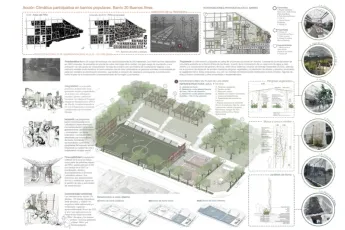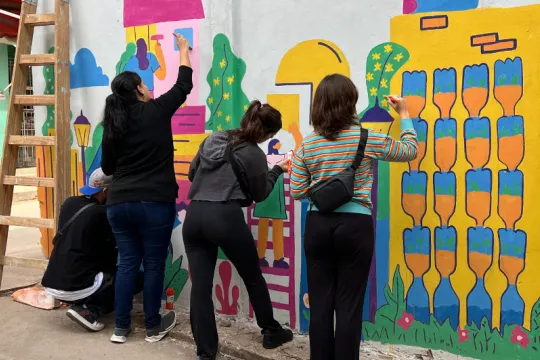
Participatory climate action in low-income neighbourhoods. Barrio 20. © IIED-AL
We are pleased to announce that the Urban Lab in Buenos Aires has been awarded third prize in the prestigious Urban Life (“Vida Urbana”) Urban Planning Competition. This competition, organized by the Spanish Agency for International Development Cooperation (AECID) in collaboration with the Ibero-American General Secretariat (SEGIB), aimed to highlight innovative ideas and proposals that promote sustainable urban transformations, improving the quality of life, particularly for the most vulnerable populations.
The award-winning proposal is part of a series of projections and interventions co-constructed by the Urban Lab under Transformative Urban Coalitions (TUC). In 2021, TUC was integrated into the ongoing redevelopment process of Barrio 20, coordinated since 2016 by the Housing Institute of the City of Buenos Aires.
Based on a Blue-Green Infrastructure (BGI) approach, the proposal primarily aims to reduce flood risks and improve storm-water quality through Nature-based Solutions. It also seeks to mitigate the heat island effect, capture CO2, improve air quality, offer new urban amenities, revitalize the landscape of Barrio 20 by creating spaces for social interaction and increase biodiversity by planting native flora, among other benefits. The project also aims to demonstrate the complementarity of BGI compared to conventional grey infrastructure.
The proposal considers the revitalization of Plaza de las Risas in Barrio 20, initiated under TUC, as its starting point. Adding to this ongoing transformation, constructing two open-air water reservoirs, incorporating rain gardens and other Sustainable Urban Drainage Systems (SUDS), was conceived. The reservoirs, if built, would have a water storage capacity of 780 m³, while the rain gardens would absorb and treat 100 m³, helping to mitigate flooding risks in the area. These solutions are complemented by vegetated pergolas and the planting of native trees and shrubs, part of which has already been carried out under the TUC project, providing shade and improving the quality of public space.
These interventions propose adding 175 trees, 110 climbing plants, 2430 shrubs, and 1285 m² of added or revitalized green areas. They capture approximately 30 tons of CO2 per year.
The proposal, aimed at imagining different urban futures, presented the potential of nature-based solutions to transform vulnerable urban areas. These interventions would generate immediate environmental and social benefits and establish a replicable model for future redevelopment initiatives in similar contexts.
